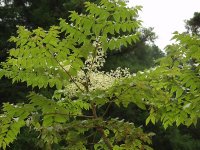Aralia - aralia l.
Family Aralievye - Araliaceae
Botanical characteristics. A small tree or a bush. It grows in woods, on burnings and felling.
The bark of old trees is gray, wrinkled, young - light yellow, covered with tiny spines. Leaves are large, up to 1 m in length, twofold or threefold. Leaflets elliptical, cordate or ovate, edge-shaped, glabrous from above, bristly below. The flowers are white or creamy-yellow, fragrant, in the large terminal inflorescence. Fruit juicy globular, blue-black or black. Blossoms in July - August, fruits ripen in September - October. There are 2 species.
- Aralia high - A. elata Seem. Leaves are twice-pinnate, complex, nearer to apex pinnate. Leaflets are more often ovate, from below they are gray, completely velvety-gustoopushenne. The flowers are yellowish, small, in the final panicles. Fruits are black with five, less often with six seeds. Blooms in August, bears fruit in October.
- Aralia Manchu - A. mandshurica Rupr. The leaves are regular, concentrated at the apex, very large. Leaflets ovate or elliptical. The flowers are white or cream-yellow in numerous umbrellas. Fruits are blue-black. Blooms in July - August. Fruits ripen in September.
Both species are close to each other in appearance, close in chemical composition, have similar healing properties.
Used parts of the plant. Medicinal raw materials are flowers, leaves, fruits, bark, kidneys collected in the usual way.
Chemical composition. All parts of the plant contain carbohydrates, coumarins, essential oil. The kidneys contain organic acids; Flowers and leaves - flavonoids, anthocyanins, vitamins; Seeds - fatty oil. From the roots are isolated alkaloids, triterpene compounds - aralosides A, B and C, which are glycosides of oleanolic acid.
Application. Galenic preparations of aralia in the experiment cause excitation of the central nervous system, which is superior in activity to the effect of preparations of ginseng and eleutherococcus. Water extracts from the roots stimulate the reproduction of yeast cells. The root extract has a gonadotropic effect, stimulates breathing, dilates the blood vessels.
Preparations of aralia have a preventive and curative effect in experimental radiation sickness and alloxan diabetes in animals. The antistress effect of the Manchu aralia is established. Tincture of the roots is used for hypotension and asthenia, with the initial stages of atherosclerosis, physical and mental fatigue, schizophrenia, impotence, craniocerebral trauma. In healthy people, aralia increases physical performance, exhibits antitoxic, cardiotonic, hypotensive effects.
In medicine, the drug "Saparal" is known, used as a tonic for asthenodepressive states, neurasthenia, hypotension, mental and physical overwork.
Aralia is part of the tonic drinks "Sayany", "Aralman", acting like "Coca-Cola."
In folk medicine, decoctions and infusions of flowers, leaves, bark and roots are used for catarrhal diseases, kidney diseases, gastrointestinal tract, atherosclerosis, and diabetes mellitus.
Coumarins contained in the plant show antitumor activity.
Nanais are used as anti-inflammatory drugs for toothache, Chinese - as a diuretic, Japanese - for diabetes, as a sedative, with kidney disease.
Preparation
- For infusion take 20 g of flowers or leaves, pour 200 ml of boiling water, insist on a water bath for 15 minutes, cool 45 minutes, filter. Take 1/3 cup 2-3 times a day.
- From the bark and roots prepare a decoction , for which take 15 g of bark or roots, grind, pour boiling water 180 ml, insist 30 min, cool 10 min, filter. Take 2 tbsp. Spoon 3-4 times a day.




Comments
Commenting on, remember that the content and tone of your message can hurt the feelings of real people, show respect and tolerance to your interlocutors even if you do not share their opinion, your behavior in the conditions of freedom of expression and anonymity provided by the Internet, changes Not only virtual, but also the real world. All comments are hidden from the index, spam is controlled.